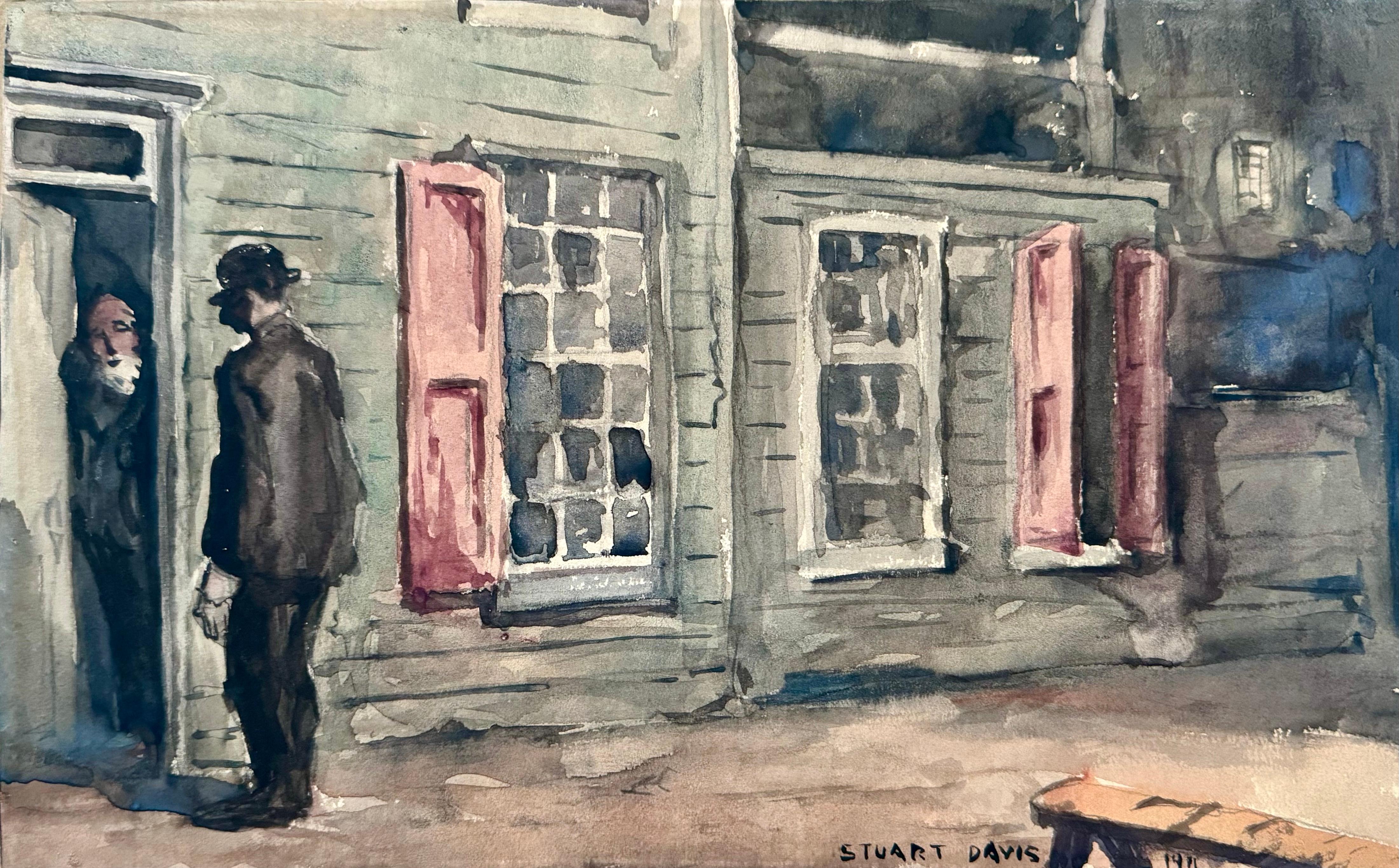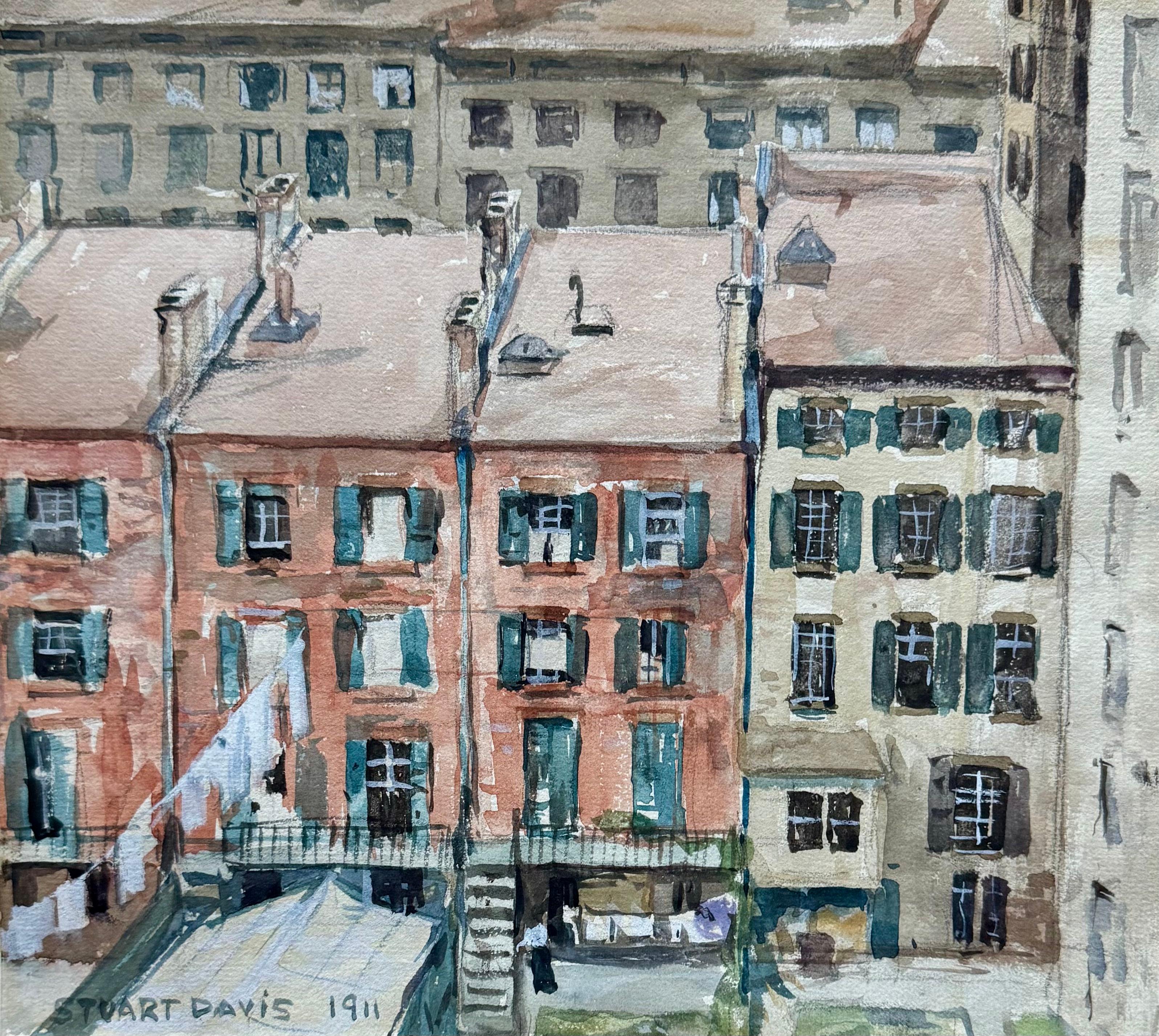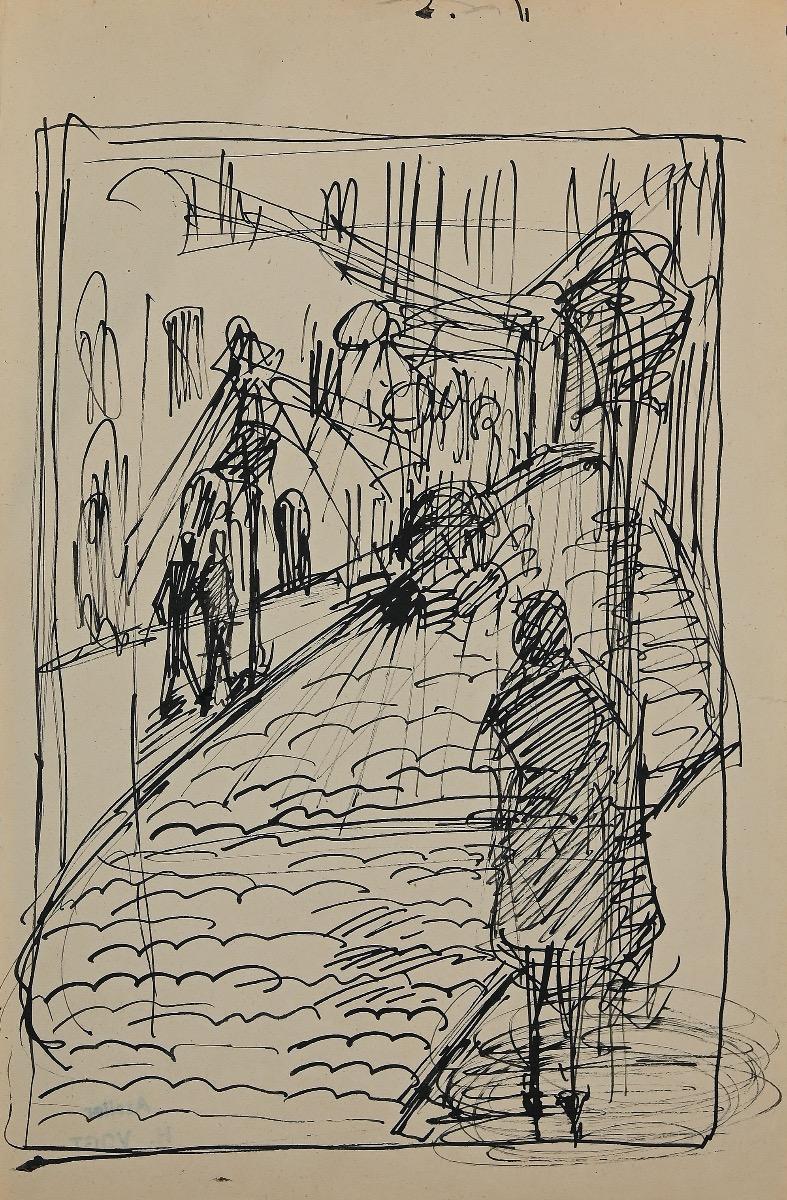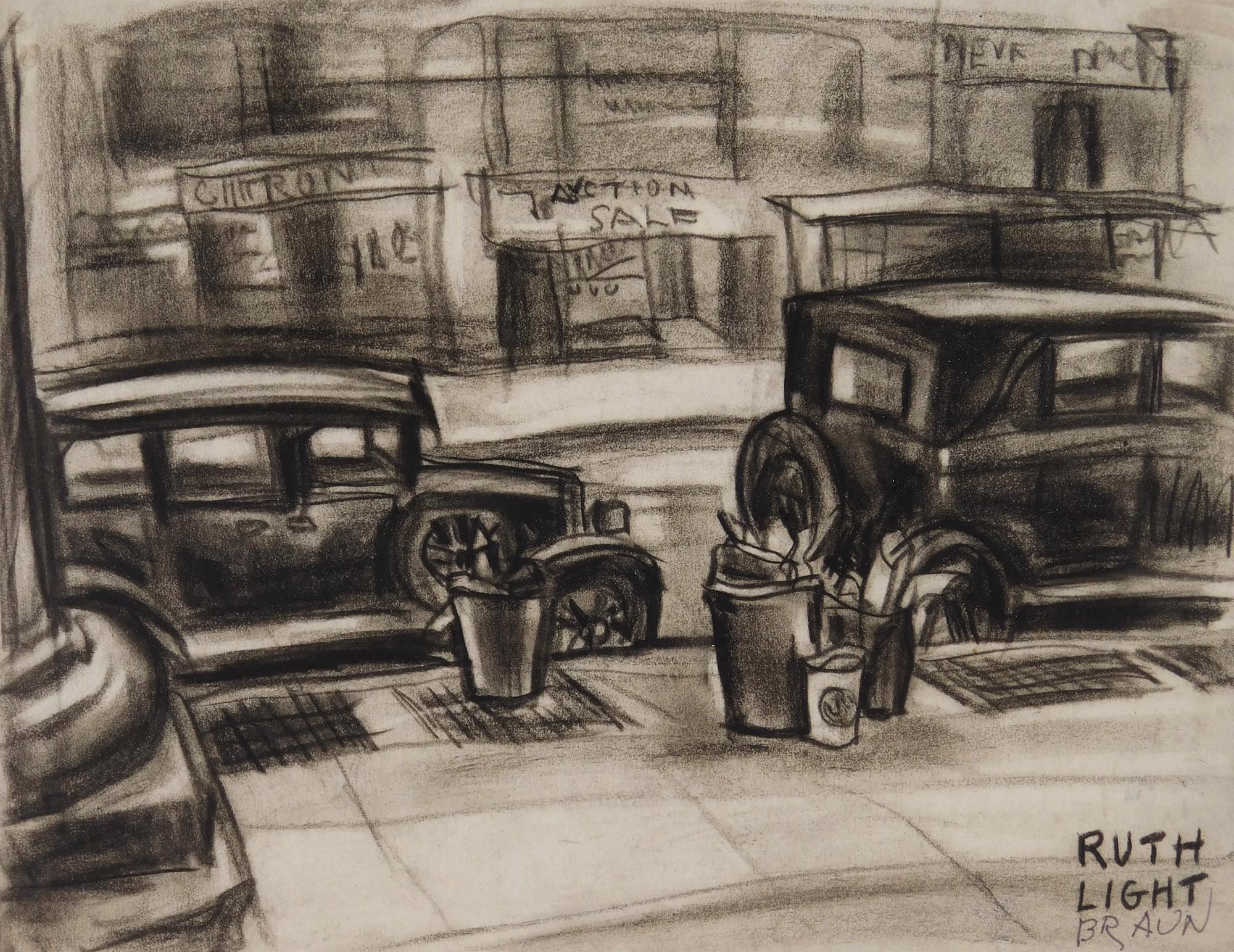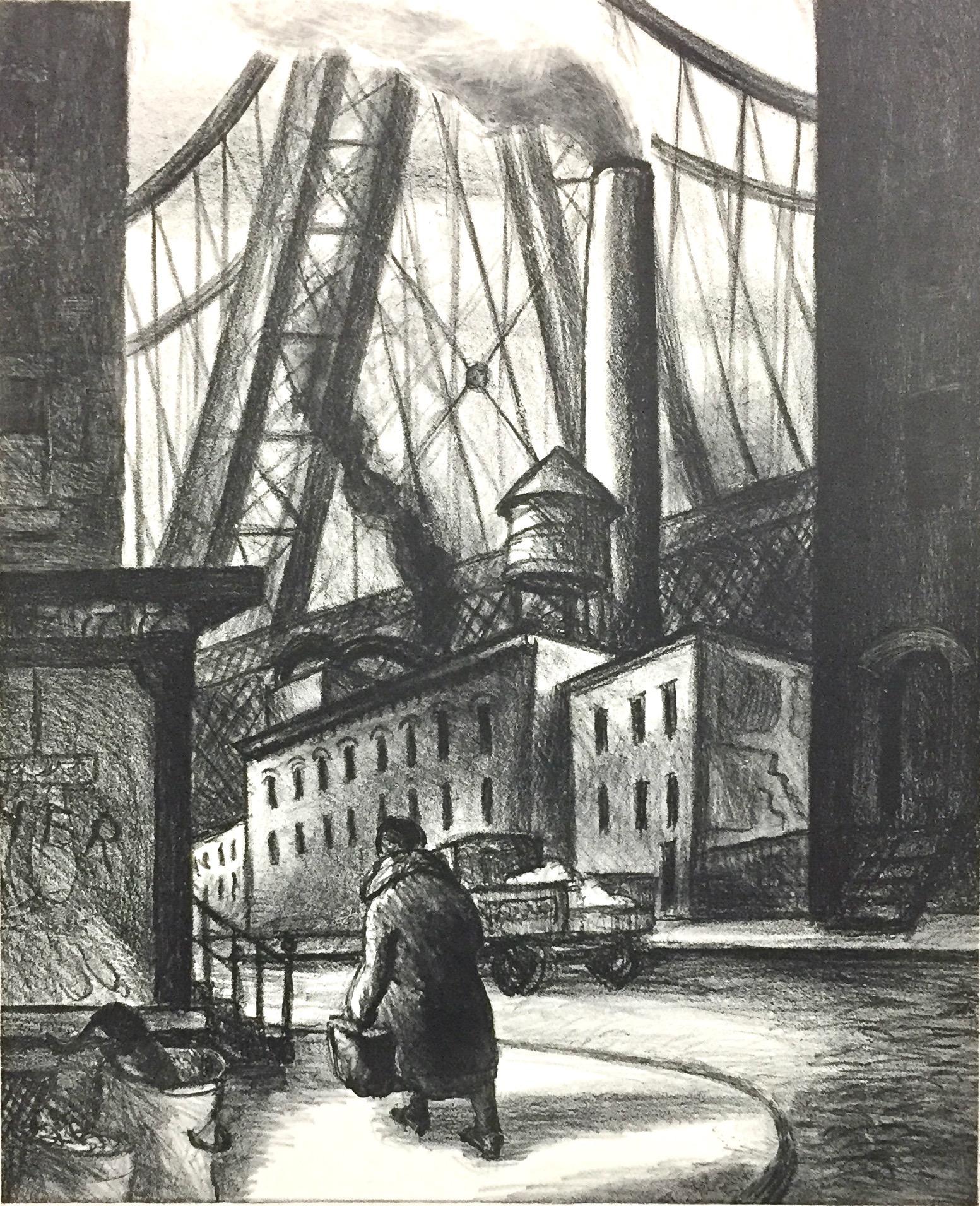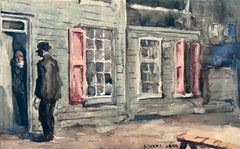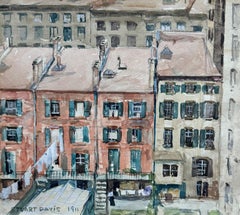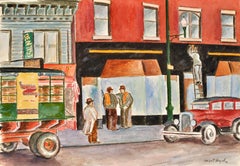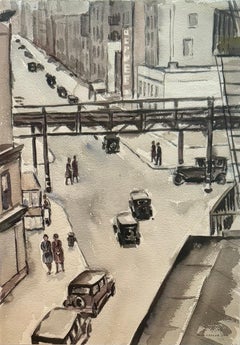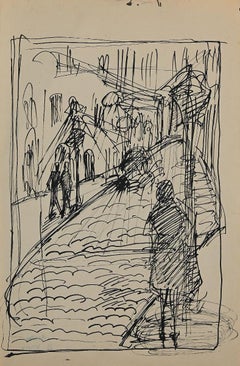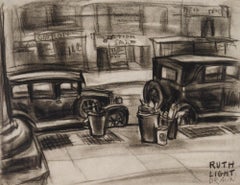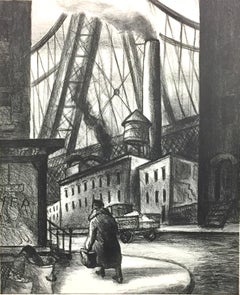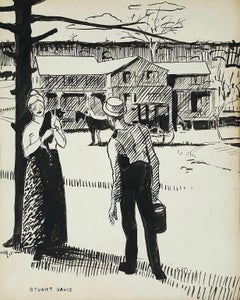Items Similar to Two Men on a Street Early 20th Century w/c Fauvism Social Realism American Scene
Want more images or videos?
Request additional images or videos from the seller
1 of 10
Stuart DavisTwo Men on a Street Early 20th Century w/c Fauvism Social Realism American Scene1911
1911
$100,000
£76,159.22
€87,669.51
CA$143,308.06
A$156,798.17
CHF 80,907.42
MX$1,877,641.30
NOK 1,027,157.95
SEK 962,347.97
DKK 654,709.44
About the Item
Two Men on a Street Early 20th Century w/c Fauvism Social Realism American Scene
Note: We have three similar in style works from 1911 available now on 1stDibs. All are framed identically by Bark.
The three drawings are shown together on page 452 of the Stuart Davis Catalogue Raisonne, as seen in the attached photos.
Stuart Davis (1892-1964)
"Two Men on a Street"
7 15/16” x 12 11/16 inches
Watercolor on paper
Signed and dated 1911
Framed by Bark: 15 x 20 inches
LITERATURE: A, Boyajian, M. Rutkowski, Stuart Davis, A Catalogue Raisonne, Vol. 2, New Haven, Connecticut, 2007, vol. II, p. 452, illustrated.
Provenance:
Estate of Joan Bardenheier Harrison, from a proud St. Louis Family of German descent. Her family founded the John Bardenheier Wine and Liquor Company in 1873, later named the Bardenheier Wine Cellars. At its peak, the winery was one of the oldest and largest family owned and operated wineries in the United States.
BIO
Born in Philadelphia in 1892, Stuart Davis is known by many art historians as the American painter most influenced by Cubism. Art historian Norman Geske described Davis' career as a "near classical demonstration of the process by which American painting of the twentieth century came of age." (40). Davis moved from journalistic illustration to Social Realism, to Expressionism, to Cubism, ultimately becoming one of America's leading abstractionists. Strongly influenced by Fernand Leger and the New York Armory Show of 1912, he developed his own unique style of Cubism, which also incorporated Realism.
Along with Max Weber, he is credited with being the importer of Cubism to the United States from France at a time when the public was more interested in Social Realism and American Scene painting with people and places that were recognizable.
Through his painting, he pursued a life-long quest of finding a logical set of assumptions from which he could produce a modern picture, and the results were strong, related patterns and compelling color combinations. In addition to paintings, his body of work includes drawings, collages, lithographs, gouaches, and murals.
Stuart Davis was born in Philadelphia to artistic parents. His mother was sculptor Helen Stuart Foulke, and his father, Edward Wyatt Davis, was art editor of the Philadelphia Press. Through his father, he had early association with John Sloan and Robert Henri, with whom he studied in New York City from 1910 to 1913. The Armory Show of 1912 dissuaded him from following the realist styles of Sloan and Henri, but he maintained his artistic focus on aspects of the social realism they espoused in that many of his subjects were places such as run-down hotels or apartment interiors.
Davis experimented with Cubism, collage, and total abstraction, and eventually settled on a style based on Cubism with much improvisation. In the late 1920s, he lived in Paris in Jan Matulka's studio close to other modernists including Alexander Calder, Isamu Noguchi, and Morris Kantor. Then he returned to New York City, in whose vicinity he spent the remainder of his career. He had a New York City studio and also a studio in Hoboken, New Jersey. From that time, his paintings reflected American experience, especially his love of jazz music, with the modernist styles he employed beginning with the Armory Show of 1913.
In the 1930s, he taught at the Art Students League in New York, and he also did murals for the WPA (Works Progress Administration). In the 1940s, he taught at the New School for Social Research. In 1964, he received the first commission by an American artist to design a postage stamp, which was issued six months after his death in that year.
His first exhibition was in 1927 and venues included the Phillips Gallery in Washington DC , and the Whitney Museum in New York. In this exhibition, he introduced his landmark "Eggbeater Series", various depictions of an eggbeater, a fan and a glove, with each one increasingly abstract until only pure abstraction remained.
A 1998 retrospective of his work was organized by curators of the Peggy Guggenheim Collection in Venice, and its last venue was The National Museum of American Art in Washington D.C.
- Creator:Stuart Davis (1892-1964, American)
- Creation Year:1911
- Dimensions:Height: 15 in (38.1 cm)Width: 20 in (50.8 cm)
- Medium:
- Movement & Style:
- Period:
- Condition:
- Gallery Location:New York, NY
- Reference Number:1stDibs: LU1156213569712
About the Seller
5.0
Gold Seller
Premium sellers maintaining a 4.3+ rating and 24-hour response times
Established in 2008
1stDibs seller since 2019
195 sales on 1stDibs
Typical response time: <1 hour
- ShippingRetrieving quote...Shipping from: New York, NY
- Return Policy
Authenticity Guarantee
In the unlikely event there’s an issue with an item’s authenticity, contact us within 1 year for a full refund. DetailsMoney-Back Guarantee
If your item is not as described, is damaged in transit, or does not arrive, contact us within 7 days for a full refund. Details24-Hour Cancellation
You have a 24-hour grace period in which to reconsider your purchase, with no questions asked.Vetted Professional Sellers
Our world-class sellers must adhere to strict standards for service and quality, maintaining the integrity of our listings.Price-Match Guarantee
If you find that a seller listed the same item for a lower price elsewhere, we’ll match it.Trusted Global Delivery
Our best-in-class carrier network provides specialized shipping options worldwide, including custom delivery.More From This Seller
View AllAnswering the Door Early 20th Century w/c Fauvism Social Realism American Scene
By Stuart Davis
Located in New York, NY
Answering the Door Early 20th Century w/c Fauvism Social Realism American Scene
Note: We have three similar in style works from 1911 available now on 1stDibs. All are framed identi...
Category
1910s American Realist Figurative Drawings and Watercolors
Materials
Paper, Watercolor
"Backyards" Early 20th Century Watercolor Fauvism Social Realism American Scene
By Stuart Davis
Located in New York, NY
"Backyards" Early 20th Century Watercolor Fauvism Social Realism American Scene
Note: We have three similar in style works from 1911 available now on 1stDibs. All are framed identic...
Category
1910s American Realist Figurative Drawings and Watercolors
Materials
Paper, Watercolor
"Streetscape" American Scene WPA Social Realism Mid 20th Century Industrial
Located in New York, NY
"Streetscape" American Scene WPA Era Social Realism Mid 20th Century Industrial
Herbert Heyel (American 1907-2000)
"Streetscape"
14 x 20 inches
Watercolor on paper, c. 1939
Signed l...
Category
1930s American Realist Landscape Drawings and Watercolors
Materials
Paper, Watercolor
"6th Avenue El" American Scene Social Realism Mid-20th Century Cityscape Modern
By Max Arthur Cohn
Located in New York, NY
"6th Avenue El" American Scene Social Realism Mid-20th Century Cityscape Modern
Max Arthur Cohn (1903-1998)
6th Avenue Elevated
19 1/4 x 13 3/4 inches
Watercolor on paper
Signed an...
Category
1920s American Modern Figurative Drawings and Watercolors
Materials
Paper, Watercolor
6th Avenue El at 8th St NYC Cityscape American Scene Social Realism Mid-Century
By Max Arthur Cohn
Located in New York, NY
6th Avenue El at 8th St NYC Cityscape American Scene Social Realism Mid-Century
Max Arthur Cohn (1903-1998)
6th Avenue El at 8th Street
13 x 18 inches
Watercolor on paper, c. 1930
...
Category
1930s American Modern Figurative Drawings and Watercolors
Materials
Paper, Watercolor
"3rd Avenue EL" NYC American Scene Ashcan WPA Modern 20th Century Social Realism
By Bernard Gussow
Located in New York, NY
"3rd Avenue EL" NYC American Scene Ashcan WPA Modern 20th Century Social Realism
Bernard Gussow (1881-1957)
3rd Avenue El
28 1/8 x 30 1/4 inches
Oil on canvas
Signed lower left
Fram...
Category
1930s American Realist Figurative Paintings
Materials
Canvas, Oil
You May Also Like
Street with Figures - Original Pencil and Ink by Helen Vogt - 1929
By Helen Vogt
Located in Roma, IT
Street with figures is an original pencil and china ink drawing realized by Helen Vogt, in 1929.
The state of preservation is very good.
Not signed.
Stamp of the artist on the ...
Category
1920s Modern Landscape Drawings and Watercolors
Materials
Ink, Pencil
Gritty Street Scene with Parked Cars - Roaring Twenties New York
By Ruth Light Braun
Located in Miami, FL
A gritty New York City street scene with period Roaring Twenties Cars and stuffed metal garbage cans is depicted by female artist Ruth Light Braun. ...
Category
1920s Post-Impressionist Landscape Drawings and Watercolors
Materials
Paper, Crayon
Leonard Pytlak, Side Street (New York City)
By Leonard Pytlak
Located in New York, NY
This lithograph is signed in pencil.
Leonard Pytlak lived on the East Side of Manhattan and this image recalls the 59th Street Bridge (also known as the Queensboro Bridge and the Ed Koch Queensboro Bridge), completed in 1909. It goes from Manhattan to Queens and passes over Roosevelt Island...
Category
1930s Ashcan School Landscape Prints
Materials
Lithograph
Country Life
By Stuart Davis
Located in Miami, FL
Early work when Stuart Davis was an illustrator.
Christie's, New York
Catalogue Raisonné
Category
1920s American Realist Figurative Drawings and Watercolors
Materials
India Ink, Pencil
Country Life Illustration
By Stuart Davis
Located in Miami, FL
Early work when Stuart Davis was an illustrator.
Christie's, New York
Catalogue Raisonné
Category
1920s American Realist Figurative Drawings and Watercolors
Materials
India Ink, Pencil
Main Street, 1923
By Raeburn Van Buren
Located in Fort Washington, PA
Medium: Black Pen and Paper
Signature: Signed Lower Left
Subject matter features a group of men and women dressed in 1920's attire, gathered on a main street...
Category
1920s Figurative Drawings and Watercolors
Materials
Paper, Pen
More Ways To Browse
20th Century Paris Street Scenes
Early 20th Century Realism Paintings
Paintings Early 20th Century Venice
Social Realism
Davis Gray
Works In Progress
New Jersey Paintings
Social Realism Painting
Social Realism Social Realism Art 1930s And 1940s
Two Men Painting
M Stuart
Andre Smith
Charlotte Huntley
Cowboy Drawing
Grace Mcarthur
Jo Cain
John La Farge
Judi Betts
